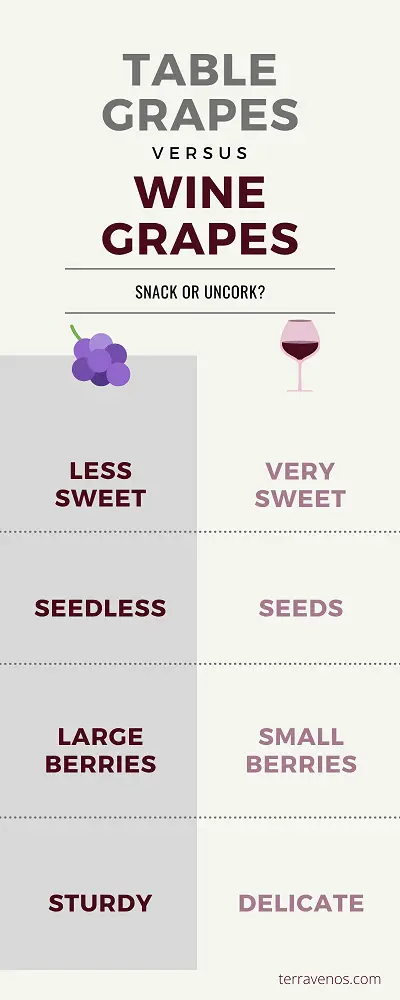
Every harvest season, I bring a few small bunches of wine grapes into the office for my co-workers. I line them up buffet-style with labels: ‘Merlot’, ‘Cabernet Sauvignon, ‘Chardonnay’, and we have a grape tasting.
Not only are wine grapes edible, but tasting wine grapes is actually one way that winemakers decide when to harvest. Wine grapes are much smaller, much softer, and much sweeter than table grapes – and you’d be surprised by the size of their large seeds. If you ever get the chance to try fresh wine grapes, go ahead and give them a munch.
What do wine grapes taste like?

Wine grapes are sweet. Very sweet.
The level of sugar in the grape correlates to the final alcohol level in the bottle of wine.
Berries destined for the bottle need to reach a certain level of sugar ripeness.
Too little sugar and the wine won’t have enough alcohol. Too much sugar and the wine will be overly alcoholic and the wine yeast will have trouble fermenting the wine to dryness.
Because sugar levels are so important in the final wine style, ripe wine grapes will taste intensely sweet compared to your standard table grape.
The #1 comment I hear from friends who try wine grapes for the first time: “Wow! These are really sweet! I didn’t expect that.”
This discovery makes sense because your average table wines are dry. It seems counterintuitive.
Another surprise for most people is the seeds.
Grape seeds give the wine tannin structure. This is the astringency or drying component in red wine.
Ripe seeds help create riper tannins in the wine, sometimes offering a spicy note. Underripe seeds give green tannins, and the wine can come off as stemmy or grassy.
The seed-to-berry ratio is actually quite small, meaning that the seeds are large compared to the size of the tiny grape berry.
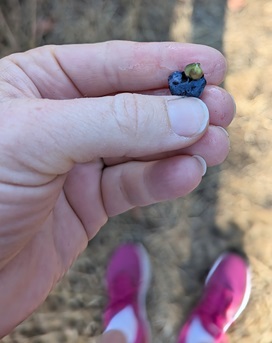
Depending on the grape variety, the wine grape berry may be one-third of the size of your standard table grape, about the size of a chickpea.
Now imagine that the seeds are the same size as your standard table grape seeds (No doubt you probably prefer seedless table grapes – I know that I do!). You can see how seed size is a shock for people who have never tasted a wine grape before.
It’s okay to eat wine grape seeds.
You’ll have trouble spitting out the seeds while you’re popping wine grape berries in your mouth – the seed-to-fruit ratio makes it challenging. So don’t bother trying.
In fact, you should eat wine grape seeds. It’s part of the overall assessment of the berry. Go ahead and eat the whole thing, seeds and all.
Wine Grapes Are Fragile
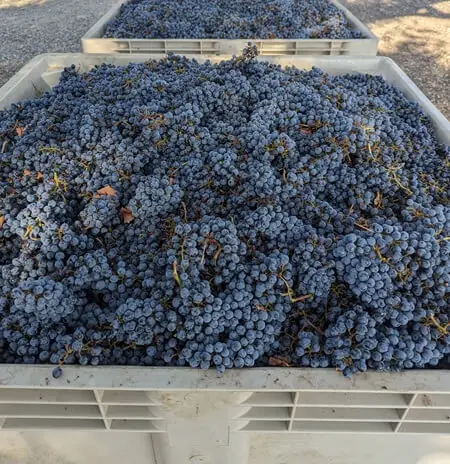
Farmers and viticulturalists have selectively bred table grapes to make them hardy for transport. Here locally, I know that our table grapes come up from Chile during the winter months. A 3000+ mile journey requires resiliency, especially if you’re a grape.
Wine grapes are picked at the peak of ripeness and (generally speaking) crushed not too far from the vineyard.
Often, they get crushed by their own weight during transport to the winery (unless for some reason the destined wine style requires gentle handling).
Squished grapes aren’t necessarily a bad thing.
The signature passion fruit and punchy aromatics of New Zealand Sauvignon Blanc can actually be traced back to some berries getting crushed during the harvest process.
When I go to pick up my grapes, I pass a large commercial winery. Huge semi-trucks with gondolas of grapes turn into the facility. As they do, crushed grape juice splashes onto the road. Driving past the winery during harvest feels like driving through rain puddles with grape juice coating the underside of your car.
Wine grapes are delicate compared to their table grape cousins.
Do wine grapes taste like the wine they make?
Wine grapes will taste a little like the wines they make. A wine’s flavor compounds come from the grape’s skins and seeds. Some of these compounds are obvious in the grape.
You may taste a little spice, black pepper, and even mintiness.
Other flavors are locked inside the grape waiting for the chemical process of fermentation to unlock them or transform them.
You won’t be able to taste these compounds in fresh grapes and will have to wait until they become wine.
How to ‘Taste’ a Wine Grape
No, I’m not being pretentious here. Bear with me.
We ‘taste’ wine, so it’s only fitting that we ‘taste’ wine grapes.
When you’re tasting a wine grape, focus on any green flavors. This will be like an underripe piece of fruit – whether it’s an underripe strawberry, apple, peach, or blackberry. The fruit will taste astringent and tight.
Also, focus on where you taste the flavor in your mouth physically.
Is it towards the tip of your tongue in the front of your mouth? Or does it happen more towards the middle of your mouth?
Underripe wine grapes will taste firm in the front of your mouth. Riper grapes move the flavors towards the middle and back of your mouth.
Who Eats Wine Grapes?
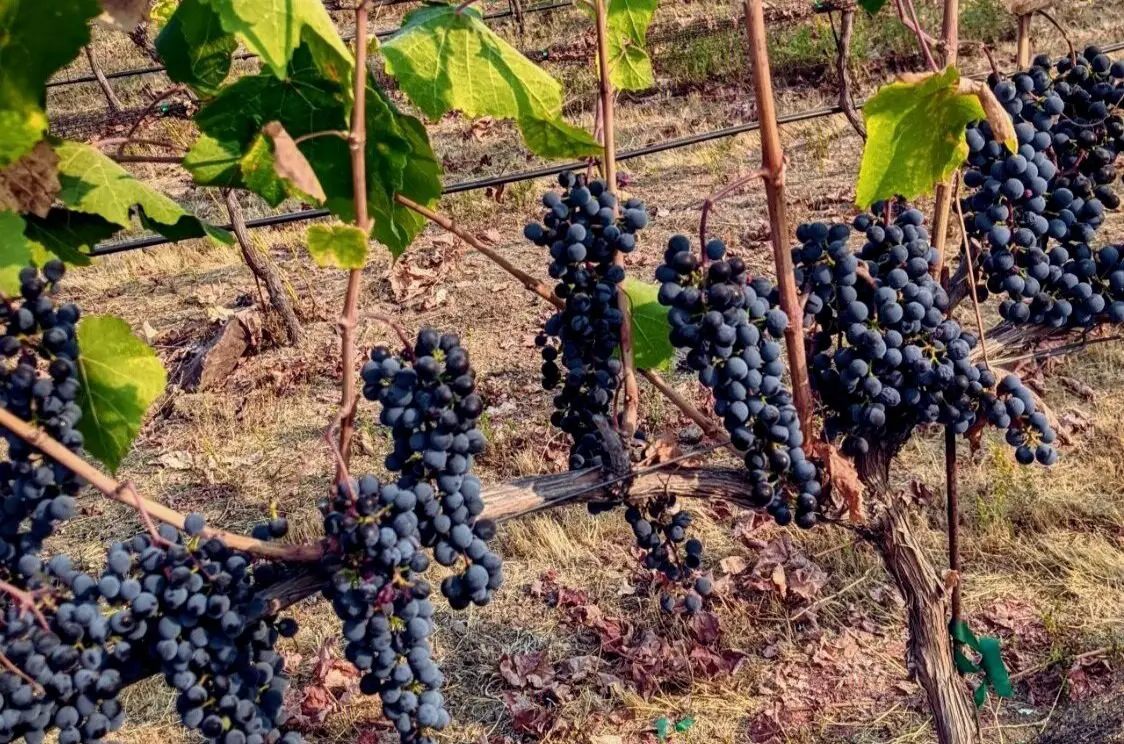
People don’t eat wine grapes for pleasure, the seeds are too big, and the berries are too small to really be enjoyed as a snacking fruit. Wine grapes are one of the few agricultural products that are still grown for flavor, not looks.
Other than winemakers and grape growers, numerous critters enjoy wine grapes out in the vineyard. After all, the vine’s sole purpose in putting energy into berries is to spread its seeds and propagate far and wide!
One of my close friends who has a small family vineyard always comments that he knows that the grapes are ready when the deer come out and start nibbling at the fruit.
The deer have an innate sense of when the grapes have reached peak ripeness.
Can you buy wine grapes to eat?
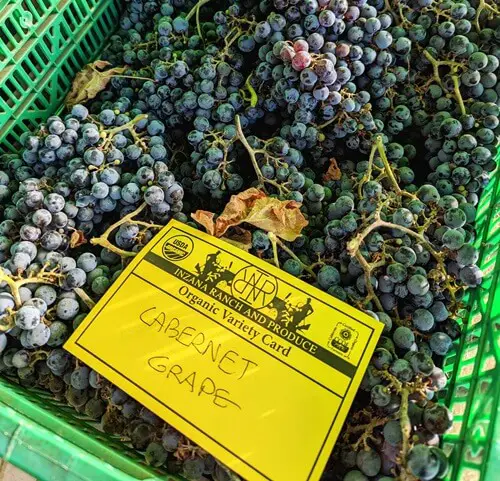
If you’re fortunate enough to live in an area that grows wine grapes, you may be able to find them at your local farmer’s market during harvest season.
You won’t find them in the grocery store simply because they’re too fragile to ship and not widely distributed.
You may be lucky enough to visit a vineyard or winery during harvest season.
The producer may take you through the vineyard where you can pick a few berries to taste.
If you take a drive through wine country when the grapes are almost ready to pick, pull off to the side of the road and try a berry or two. Don’t worry, this won’t affect the wine or impact the harvest yields.
Even better, make friends with a hobby winemaker who would love a helping hand during harvest in exchange for a bunch of grapes – and maybe a bottle or two of the finished product!
Thirsty for More?
I personally think that the best way to learn about wine is to host your own wine tastings. I put together this comprehensive list of wines and the order you should taste them. So go find some bottles and some friends and set a date!
Just getting started with wine? Here are the major wine growing regions and their signature wine styles.



